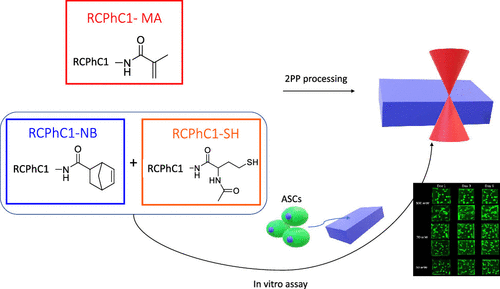当前位置:
X-MOL 学术
›
Biomacromolecules
›
论文详情
Our official English website, www.x-mol.net, welcomes your
feedback! (Note: you will need to create a separate account there.)
High-Resolution 3D Bioprinting of Photo-Cross-linkable Recombinant Collagen to Serve Tissue Engineering Applications.
Biomacromolecules ( IF 5.5 ) Pub Date : 2020-08-25 , DOI: 10.1021/acs.biomac.0c00386 Liesbeth Tytgat 1, 2 , Agnes Dobos 3, 4 , Marica Markovic 3, 4 , Lana Van Damme 2 , Jasper Van Hoorick 1, 2 , Fabrice Bray 5 , Hugo Thienpont 1 , Heidi Ottevaere 1 , Peter Dubruel 2 , Aleksandr Ovsianikov 3, 4 , Sandra Van Vlierberghe 1, 2
Biomacromolecules ( IF 5.5 ) Pub Date : 2020-08-25 , DOI: 10.1021/acs.biomac.0c00386 Liesbeth Tytgat 1, 2 , Agnes Dobos 3, 4 , Marica Markovic 3, 4 , Lana Van Damme 2 , Jasper Van Hoorick 1, 2 , Fabrice Bray 5 , Hugo Thienpont 1 , Heidi Ottevaere 1 , Peter Dubruel 2 , Aleksandr Ovsianikov 3, 4 , Sandra Van Vlierberghe 1, 2
Affiliation

|
Various biopolymers, including gelatin, have already been applied to serve a plethora of tissue engineering purposes. However, substantial concerns have arisen related to the safety and the reproducibility of these materials due to their animal origin and the risk associated with pathogen transmission as well as batch-to-batch variations. Therefore, researchers have been focusing their attention toward recombinant materials that can be produced in a laboratory with full reproducibility and can be designed according to specific needs (e.g., by introducing additional RGD sequences). In the present study, a recombinant protein based on collagen type I (RCPhC1) was functionalized with photo-cross-linkable methacrylamide (RCPhC1-MA), norbornene (RCPhC1-NB), or thiol (RCPhC1-SH) functionalities to enable high-resolution 3D printing via two-photon polymerization (2PP). The results indicated a clear difference in 2PP processing capabilities between the chain-growth-polymerized RCPhC1-MA and the step-growth-polymerized RCPhC1-NB/SH. More specifically, reduced swelling-related deformations resulting in a superior CAD-CAM mimicry were obtained for the RCPhC1-NB/SH hydrogels. In addition, RCPhC1-NB/SH allowed the processing of the material in the presence of adipose tissue–derived stem cells that survived the encapsulation process and also were able to proliferate when embedded in the printed structures. As a consequence, it is the first time that successful HD bioprinting with cell encapsulation is reported for recombinant hydrogel bioinks. Therefore, these results can be a stepping stone toward various tissue engineering applications.
中文翻译:

可光交联重组胶原蛋白的高分辨率 3D 生物打印可服务于组织工程应用。
包括明胶在内的各种生物聚合物已被应用于多种组织工程目的。然而,由于这些材料的动物来源以及与病原体传播相关的风险以及批次之间的差异,人们对这些材料的安全性和可重复性产生了极大的担忧。因此,研究人员一直将注意力集中在可以在实验室中以完全再现性生产并且可以根据特定需求进行设计(例如,通过引入额外的RGD序列)的重组材料。在本研究中,基于 I 型胶原蛋白 (RCPhC1) 的重组蛋白通过可光交联的甲基丙烯酰胺 (RCPhC1-MA)、降冰片烯 (RCPhC1-NB) 或硫醇 (RCPhC1-SH) 功能化,以实现高通过双光子聚合 (2PP) 进行分辨率 3D 打印。结果表明,链增长聚合的 RCPhC1-MA 和逐步增长聚合的 RCPhC1-NB/SH 之间的 2PP 加工能力存在明显差异。更具体地说,RCPhC1-NB/SH 水凝胶减少了与膨胀相关的变形,从而获得了优异的 CAD-CAM 模拟效果。此外,RCPhC1-NB/SH 允许在脂肪组织衍生干细胞存在的情况下处理材料,这些干细胞在封装过程中存活下来,并且在嵌入印刷结构中时也能够增殖。因此,这是首次报道重组水凝胶生物墨水成功进行细胞封装的高清生物打印。因此,这些结果可以成为各种组织工程应用的垫脚石。
更新日期:2020-10-12
中文翻译:

可光交联重组胶原蛋白的高分辨率 3D 生物打印可服务于组织工程应用。
包括明胶在内的各种生物聚合物已被应用于多种组织工程目的。然而,由于这些材料的动物来源以及与病原体传播相关的风险以及批次之间的差异,人们对这些材料的安全性和可重复性产生了极大的担忧。因此,研究人员一直将注意力集中在可以在实验室中以完全再现性生产并且可以根据特定需求进行设计(例如,通过引入额外的RGD序列)的重组材料。在本研究中,基于 I 型胶原蛋白 (RCPhC1) 的重组蛋白通过可光交联的甲基丙烯酰胺 (RCPhC1-MA)、降冰片烯 (RCPhC1-NB) 或硫醇 (RCPhC1-SH) 功能化,以实现高通过双光子聚合 (2PP) 进行分辨率 3D 打印。结果表明,链增长聚合的 RCPhC1-MA 和逐步增长聚合的 RCPhC1-NB/SH 之间的 2PP 加工能力存在明显差异。更具体地说,RCPhC1-NB/SH 水凝胶减少了与膨胀相关的变形,从而获得了优异的 CAD-CAM 模拟效果。此外,RCPhC1-NB/SH 允许在脂肪组织衍生干细胞存在的情况下处理材料,这些干细胞在封装过程中存活下来,并且在嵌入印刷结构中时也能够增殖。因此,这是首次报道重组水凝胶生物墨水成功进行细胞封装的高清生物打印。因此,这些结果可以成为各种组织工程应用的垫脚石。


















































 京公网安备 11010802027423号
京公网安备 11010802027423号